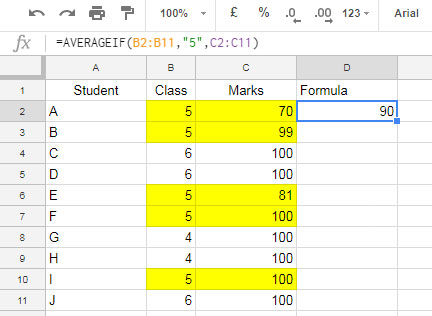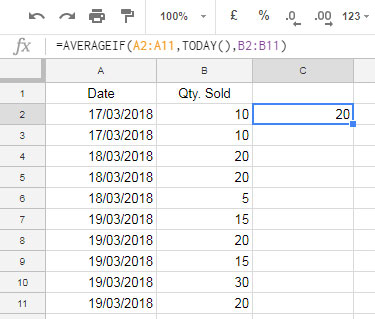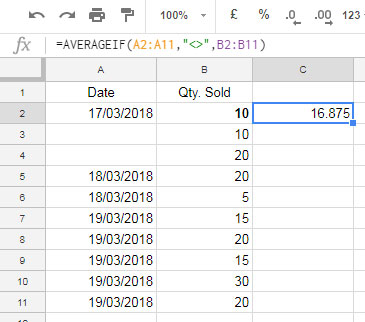The AVERAGEIF function in Google Sheets allows you to calculate averages based on a specific condition applied to a row or column. This guide explains the syntax, provides examples, and offers practical tips.
For multiple conditions, you can use AVERAGEIFS, which supports more than one criterion. Let’s dive into the syntax and usage of the AVERAGEIF function in Google Sheets.
AVERAGEIF Function: Syntax and Arguments
Syntax:
AVERAGEIF(criteria_range, criterion, [average_range])Arguments:
- criteria_range: The range to evaluate against the condition.
- criterion: The condition or pattern applied to
criteria_range. - average_range: The range of values to average. If omitted,
criteria_rangeis used.
Examples
- Average of values in B2:B100 where A2:A100 contains “Apple”:
=AVERAGEIF(A2:A100, "Apple", B2:B100) - Average of values in B2:B100 where values are greater than 200:
=AVERAGEIF(B2:B100, ">200")
Note: The AVERAGEIF function is case-insensitive.
Find Average Based on a Condition in Google Sheets
Here are some common use cases:
1. Using a Number as a Criterion
In the following example, A2:11, B2:B11, and C2:C11 contain student names, their class, and their marks, respectively.
To calculate the average marks scored by students in Class 5, use this formula:
=AVERAGEIF(B2:B11, 5, C2:C11)
You can also use double quotes for the criterion, such as "5". Google Sheets treats both 5 and "5" as equivalent when the criterion is a number.
For comparison operators (e.g., greater than or less than), numbers must be enclosed in quotes:
=AVERAGEIF(B2:B11, ">5", C2:C11)2. Using Dates as a Criterion
Dates can be tricky due to formatting differences. To ensure accuracy in the conditional average calculation, use the DATE function or the ISO 8601 format (YYYY-MM-DD).
Sample Data: A2:A11 contains sales dates, and B2:B11 contains quantities sold.
- Average quantity sold on March 19, 2018:
=AVERAGEIF(A2:A11, DATE(2018, 3, 19), B2:B11)Or:=AVERAGEIF(A2:A11, "2018-03-19", B2:B11) - Average quantity sold on or after March 19, 2018:
=AVERAGEIF(A2:A11, ">=" & DATE(2018, 3, 19), B2:B11) - The average for today’s date:
=AVERAGEIF(A2:A11, TODAY(), B2:B11)

3. Finding the Average of Non-Blank Cells
To calculate the average of non-blank cells, use the <> operator (logical NOT):
=AVERAGEIF(A2:A11, "<>", B2:B11)
4. Using Wildcards with AVERAGEIF Function
Wildcard characters (*, ?, ~) enhance flexibility with text-based conditions, and this also applies to the AVERAGEIF function:
- Asterisk (
*): Matches any number of characters.=AVERAGEIF(B2:B6, "north*", C2:C6)This matches text like “north”, “northern”, or “northwest”. - Question Mark (
?): Matches any single character.=AVERAGEIF(B2:B6, "n?rth", C2:C6) - Tilde (
~): Escapes special meanings of*and?.=AVERAGEIF(B2:B6, "north~*", C2:C6)Matches the literal text “north*”.
5. Case-Sensitive Matches in the AVERAGEIF Function
To perform a case-sensitive match, use the EXACT function with AVERAGEIF. Since EXACT is not an array function, wrap it with ARRAYFORMULA:
- Average for case-sensitive match of “Apple”:
=ARRAYFORMULA(AVERAGEIF(EXACT(A2:A7, "Apple"), TRUE, B2:B7))
Here:
EXACT(A2:A7, "Apple")returns TRUE or FALSE for each cell.TRUEis used as the criterion.






















That is exactly what I wanted. Thanks so much.
Struggling with this.
=AVERAGEIF(D2+F2+H2+J2+L2+N2+P2+R2,"0")Hi, Stephen Doyle,
I’m in the dark 🙁
If you want to find the average of the numbers in the above cells excluding zeros, then try this.
=AVERAGEIF({D2,F2,H2,J2,L2,N2,P2,R2},"<>0")Looking for something else? Please explain.
Please provide the formula if time function is used and if criteria are more than one and the criteria values of the range are time values.
e.g.
AVERAGEIF(B670:B780,{"NKCR","OKSR","SGRL","KRSL","MDMD","JRGR","BRRB","GPCK","SCDG"},H670:H780)I tried using arrayformula like below:
Arrayformula(AVERAGEIF(B670:B780,{"NKCR","OKSR","SGRL","KRSL","MDMD","JRGR","BRRB","GPCK","SCDG"},H670:H780)but this returned an average of only the first criteria “NKCR”.
Hi, Pawan Srivastava,
That’s not the correct usage of Averageif!
There are multiple solutions. Please stay tuned for my update.
Hi, Pawan Srivastava,
I have included multiple solutions to your problem in this new tutorial – How to Use Regexmatch in Averageif in Google Sheets.